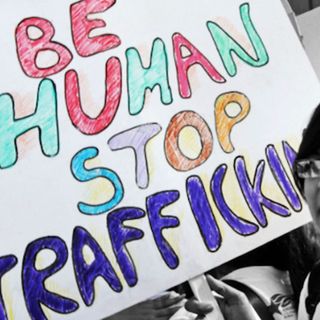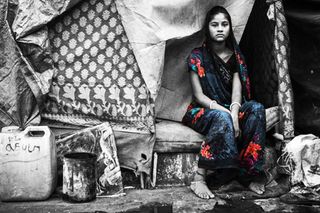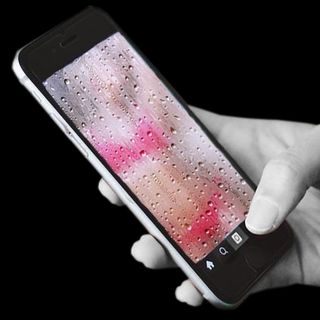
Menstruation Is a Negotiation With Survival for Many Women
We have a crisis on hand, not just of poverty and homelessness, but also of women’s basic right to privacy, safety, health, and dignity.

For the privileged, periods come with annoyance, pain and if anything, an increasingly progressive discourse around the stigma of menstruation. But for India’s crores of socio-economically disadvantaged women, menstruating comes with a lot more: stress, embarrassment, stigma and a lack of hygiene, safety, and health care. All of this is further exaggerated by illiteracy and/or a lack of education.
When we think of choices, we think of having the space to choose between two or more possibilities. But in the case of women living in poverty, especially those facing homelessness, the ‘choices’ they have to make during that time of the month, given their access to limited resources, are barely choices at all. With limited resources, these women often have to ‘choose’ between basic menstrual hygiene and self-care, and essentials such as food, water, family welfare, and even safety.
Santosh Kawade has been living on a footpath in the western suburbs of Mumbai for seven years now. Her in-laws in Khaira, Palghar, had begun physically abusing her for money (over and above the dowry her family paid) days after her marriage; four years on, she’d had enough of it. She boarded a bus to Mumbai with her son and daughter, first stopping at a Gurudwara for free food. With nowhere to go, belongings tied up in sacks, and on tired legs, she decided to settle down on a footpath near the Gurudwara, also near a public bathroom, and a snack stall.
Related on The Swaddle:
From Riches to Rags: The Evolution of Menstrual Taboos in India
“Almost every month, I have to choose between buying food and water for my children and pads for myself,” she says. “But they usually cost way more than I can afford.”
Kawade makes anywhere between Rs. 50 to Rs. 200 a day, by asking for money on the streets and outside the Gurudwara. She insists on both her children attending a school — a lofty word for a classroom run on a footpath by a good samaritan who nevertheless charges a minimum of Rs. 500 per month, per child — which leaves her with anywhere between Rs. 500 to Rs. 3000 per month for food, water, medicines, soap, clothes, plastic to cover their home when it rains, health care, and books and related educational paraphernalia for her children.
“Last month it rained a lot and my children’s books got ruined when it flooded. My daughter also fell sick. So, when I got my period I had to choose between buying pads or saving to buy their textbooks again. Each paisa counts, so I used a cloth that month,” she says, explaining why the Rs. 200 she would have otherwise spent on the cheapest variant of pads was crucial to be saved.
Then, she ran out of laundry detergent. With nothing to clean the one piece of cloth she bled onto, she folded the same rag twice till she couldn’t use it anymore. “Then, I asked a woman who lives next to us [on the footpath] to take care of my children for a few days, while I went and slept behind a public bathroom. I found some newspaper to use, but that didn’t work very well so I was just washing myself every few hours. I wish there had been soap in the bathroom for me to use,” she says.
At this point, itis important to shatter the mostly Western myth that socio-economically disadvantaged women in India don’t like to use and/or can’t afford sanitary pads. The most affordable sanitary napkin costs, on an average, Rs. 6 in Indian metro cities, which most women this writer spoke to could technically afford, but the pads become astronomically more expensive when the women have to choose between them and basic things such as food, safety, and familial survival. It is only after dividing up limited resources, encumbered underneath this illusion of choice, that sanitary pads are expensive, and therefore inaccessible to those living below or just above the poverty line. In a country-wide analysis of menstrual health sponsored by the Bill and Melinda Gates Foundation, 70% of the women surveyed said they could not afford to buy sanitary pads; it is important to gauge the deeper nuance in that statistic.
To make matters worse, disposal mechanisms for sanitary pads, such as incinerators provided by the Government of India, are often hazardous to the health of the women who operate them. According to the Gates Foundation report, many women are forced to hide or bury their pads in the middle of the night, due to a lack of bathrooms (both private and public), disposal mechanisms, and societal stigma. 53% of Indian homes lack access to toilets, “requiring women and girls to use communal or public toilets, which may be far away, or defecate in the open, increasing women’s vulnerability to violence,” according to the report, which includes accounts of women living in Delhi slums, and of men waiting in public bathrooms at night to rape women.
Related on The Swaddle:
It is as a result of these complex socio-economic factors that 88% of women in India still use old newspapers, rewashed rags (often without soap), and sawdust instead of sanitary pads. 70% of them are at risk of severe urinary tract infections, yeast infections, and toxic shock syndrome because of this.
The impact is doubly harsh on women facing homelessness, with their lack of access to pads, water, soap, a clean bathroom, and preventative and curative health care for period-related ailments.
When asked why she doesn’t move into one of the (very few) homeless shelters in the city, Kawade says, “They ask for government ID cards to allow someone into the shelter. Where will I get one from? How do I get one made now? I barely have money for pads. These shelters aren’t for people like me who don’t have money; they’re for people who have less money by Mumbai’s standards.”
*
For Rani, who recently migrated to Mumbai from her village Chhasiya, Dahod in Gujarat, it comes down to survival. She has heavy periods; “I have to change my pad every three hours easily,” she says. Along with her husband and 9-year-old daughter, Rani lives in one of the several slums that dot the city’s northern suburbs. Her husband works at a construction site and brings home enough weekly to send the daughter to school and for Rani to buy pads each month comfortably. But sometimes, Rani has to choose between the two.
“My man lusts after alcohol. Every day after work, he goes to the theka (liquor shop), drinks on the streets with his friends and comes home in a state,” she says.
Through careful saving, Rani has accumulated some money that she keeps separately and uses to run the house and educate her daughter. “Sometimes, when he has burnt through money after wasting it on alcohol, he comes home and tries to take some from what I keep. If I don’t listen to him, he hits me. A few months ago when I was on the first day of my period, he came home drunk. He asked for money and threatened to hit me if I didn’t oblige. After estimating how much I’ll need for my daughter’s fees that month and to put food on the table, I gave him the rest. We still paid my daughter’s school fees late that month though, he hit me anyway and I didn’t have any money left to buy pads after I ran out of what I had within two days of my period.”
Rani explains that while she was okay with going back to using cotton rags as she had sometimes as a young girl, her daughter’s education was non-negotiable. “It was very uncomfortable and painful; I lived outside the house that week because I was constantly staining and having to change and wash myself and the rags. I felt so ashamed that I went home for some time to my village after that. I couldn’t face anyone,” she says.
“But if I have to sometimes go through this for my daughter to study and have a better life than I do, I will. I never want her to be in such a position,” she adds, referring to the position where a woman is made to choose between getting abused, her child’s welfare and sustenance, and her right to menstruate safely, hygienically and with dignity. Not only is that choice inhumane, one can argue it’s not a choice at all: it’s systemic oppression at its worst, for simply being a woman.
The truth is we have a crisis on hand: a crisis not just of poverty and homelessness, but also a crisis of women’s basic right to privacy, safety, health, and dignity.
Pallavi Prasad is The Swaddle's Features Editor. When she isn't fighting for gender justice and being righteous, you can find her dabbling in street and sports photography, reading philosophy, drowning in green tea, and procrastinating on doing the dishes.
Related


One Year Since the Section 377 Verdict, What Has Changed?
